Effects
Valeton GP-100

| Il Valeton GP-100 è un processore multieffetto compatto ed economico che offre qualità, suoni e potenti funzioni sia per i musicisti entry-level che per i musicisti avanzati. Questa macchina del suono di facile utilizzo ti condurrà nel leggendario territorio del rock 'n' roll. All'interno del GP-100 è stato installato un potente sistema di modellazione digitale HD, che offre un suono organico ed oltre 140 effetti tra cui 45 leggendarie simulazioni di amplificatori per chitarra / basso / acustica, 40 IR di cabinet di alta qualità ed altro ancora. Ti offre anche 198 preset (99 utenti + 99 di fabbrica) ottimizzati da musicisti professionisti esperti per riprodurre qualsiasi genere musicale che ti piaccia. Il GP-100 offre 20 slot per l'archiviazione di IR utente. Personalizza subito il tuo suono! Il GP-100 dispone di un looper pre-effetti il che significa che, quando si cambiano effetti / patch, cambia anche il suono del loop. Questo è molto comodo per modificare le frasi in loop e portare la tua ispirazione ad un livello successivo. Usa il looper, la drum machine e l'ingresso aux integrati per suonare con le tue tracce. Il looper dispone di si un tempo di loop di 90 secondi e la drum machine ti offre 100 diversi pattern (metronomi inclusi). |
Caratteristiche
- Elaborazione del segnale a 24-bit / 44,1kHz
- La tecnologia di modellazione digitale avanzata offre un suono organico
- Oltre 140 effetti di alta qualità
- Catena effetti modificabile
- 45 Amplificatori leggendari per chitarra / basso / acustica
- 40 Cabinet IR di fabbrica
- Supporta la memorizzazione di 20 IR utente
- Oltre 50 effetti dinamici / drive / EQ / mod / delay / riverbero
- Funzione interfaccia audio USB con streaming audio stereo
- Modalità Stompbox e Preset per diverse situazioni
- 198 preset (99 di fabbrica, 99 utente)
- Looper di alta qualità
- 100 Pattern di batteria di alta qualità
- Chassis e pedaliera in robusto metallo
- Accordatore cromatico incorporato
- Editor intuitivo per PC / Mac
- Uscite stereo da 1/4"
- Uscita cuffie da 1/8"
- Ingresso Aux stereo da 1/8"
- Pedale di espressione incorporato
- Alimentazione 9V
- Dimensioni: 198 x 134 x 28mm
- Peso: 800g
Nux MG-30
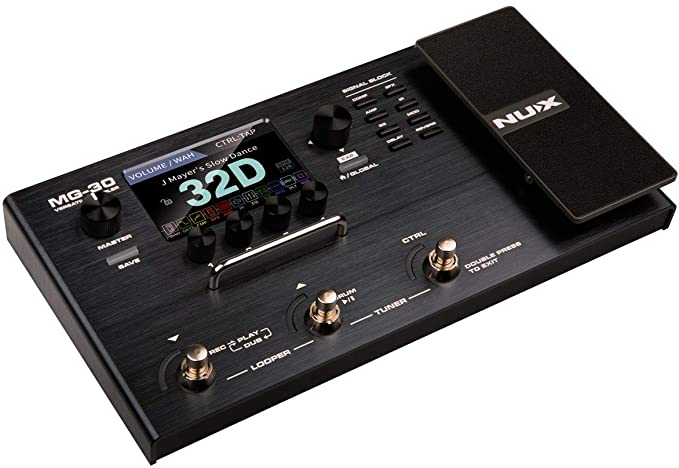
| MG-30 spinge l'algoritmo Modeling NUX a un livello superiore: da HD a 2K! I musicisti attivi sul campo hanno bisogno di qualità più che di quantità, per questo NUX si è focalizzata sui grandi classici includendo 25 modelli di amp per elettrica, 2 per acustica e 3 per basso. Con la migliore tecnologia IRs, una sezione FX completissima, looper + drum machine integrati e una connettività di primissimo livello, MG-30 è un vero arsenale per registrare, suonare in sala prove, in casa e naturalmente sul palco. E col software NUX Quick Tone™ puoi modificare paramteri, scaricare patch, caricare IRs di terze parti e settare il routing audio via USB. |
Caratteristiche
- 25 modelli di amp per elettrica, 2 per acustica e 3 per basso
- Ampio display 4" a colori per una navigazione semplice e intuitiva
- FX: Wah, Comp, Gate, Efx, Eq, Mod, Dly, Rvb) e Block Routing
- Drum machine e looper integrati (56 ritmi e loop da 60 secondi)
- Frequenza campionamento: 48kHz
- Latenza di sistema: 2ms
- Range dinamico: ~ 110dB
- Processori: 2 x NXP® RT
- Audio Codec: 2 x AD/DA AKM AK4558EN 32-bit
- Pedale di espressione integrato (multi funzione) + footswitch NMP-2 (incluso)
- Quick Tone editor software
- Alimentazione: 9V DC centro negativo
- Include: alimentatore 9V, NMP-2 footswitch, cavo patch, cavo USB
- Dimensioni: 313x166x54 mm
- Peso: 1.5 kg
Nux MG-300
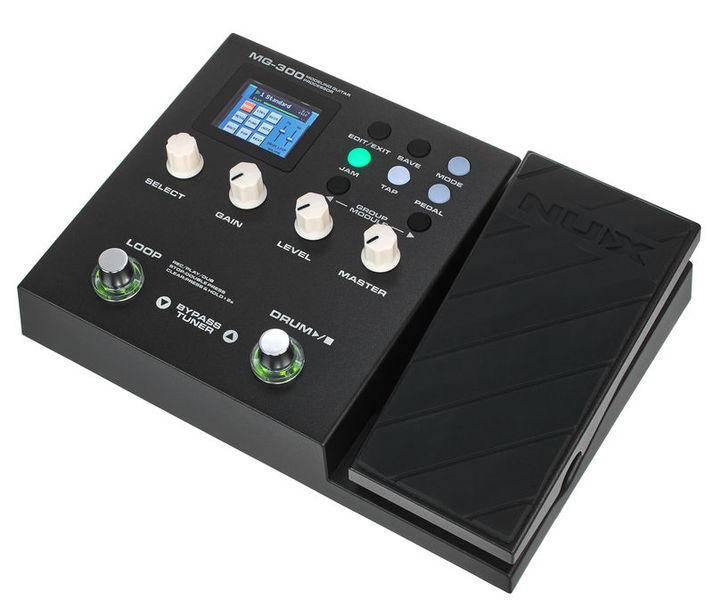
|
Hotone Ampero
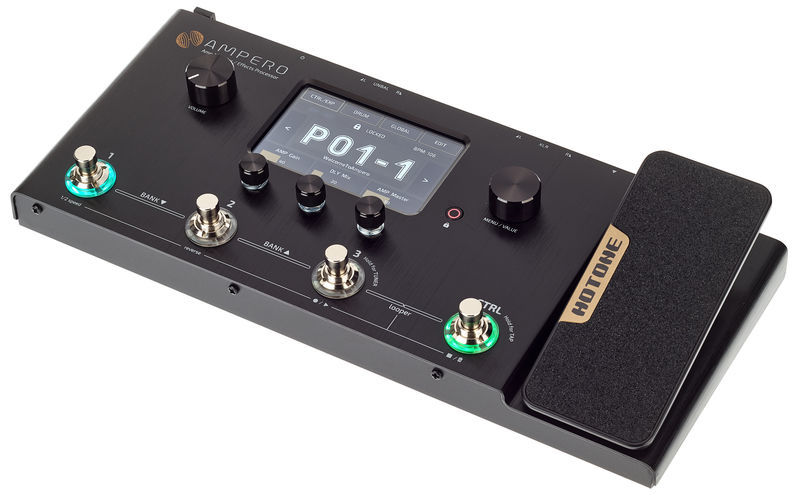
Caratteristiche
|
Line6 Pod Go

| Line 6 POD Go abbina i controlli tradizionali ad un ampio display LCD a colori per consentire ai chitarristi di interagire con amplificatori, pedali e cabinet virtuali in modi nuovi e significativi. Sia che tu stia usando effetti dal vivo in un amplificatore sul palco, registrando e ri-amplificando tramite amplificatori e cabinet modellati o usando ricchi suoni derivati da Helix direttamente dal palco al PA, il POD Go ti segue. Il prezzo e la semplicità del POD Go adattano questo processore da pavimento ai chitarristi che erano più restii ad immergersi nell'ecosistema Line 6; nonostante vanti una libreria audio premium della famiglia HX - Blackface, Plexi Lead, Treadplate e tutti i tuoi preferiti siano qui - c'è solo una breve curva di apprendimento tra il POD Go e l'integrazione totale con il tuo rig. Una volta sperimentata la libertà di esibirti con nient'altro che la chitarra sulla spalle e il Line 6 POD Go ai tuoi piedi, potresti non trascinare mai più un amplificatore dalla tua sala prove. |
Caratteristiche
- Processore da pavimento ottimizzato con 270+ modelli Helix e legacy, pedali e cabinet
- Costruzione leggera con qualità da tour
- Progettato per suonare alla grande in un amplificatore o PA
- Cattura il timbro e la sensazione di suonare attraverso vero amplificatore valvolare e pedali FX
- Lo schermo a colori di grandi dimensioni è facile da vedere anche al buio
- Il pedale di espressione integrato consente di usare wah, volume ed effetti rotanti dinamici
- La funzione Snapshot ti consente di salvare e richiamare i suoni per ogni sezione di un brano
- Supporta le risposte all'impulso di cabinet di terze parti per una maggiore espandibilità
- L'interfaccia audio USB 4x4 fornisce suoni in una sessione di registrazione in alta definizione 24/96
- Loop FX integrato e uscita cuffie
- Uscita Dry per usare un rig tradizionale mentre si inviano suoni elaborati al FOH
Line6 HX Stomp
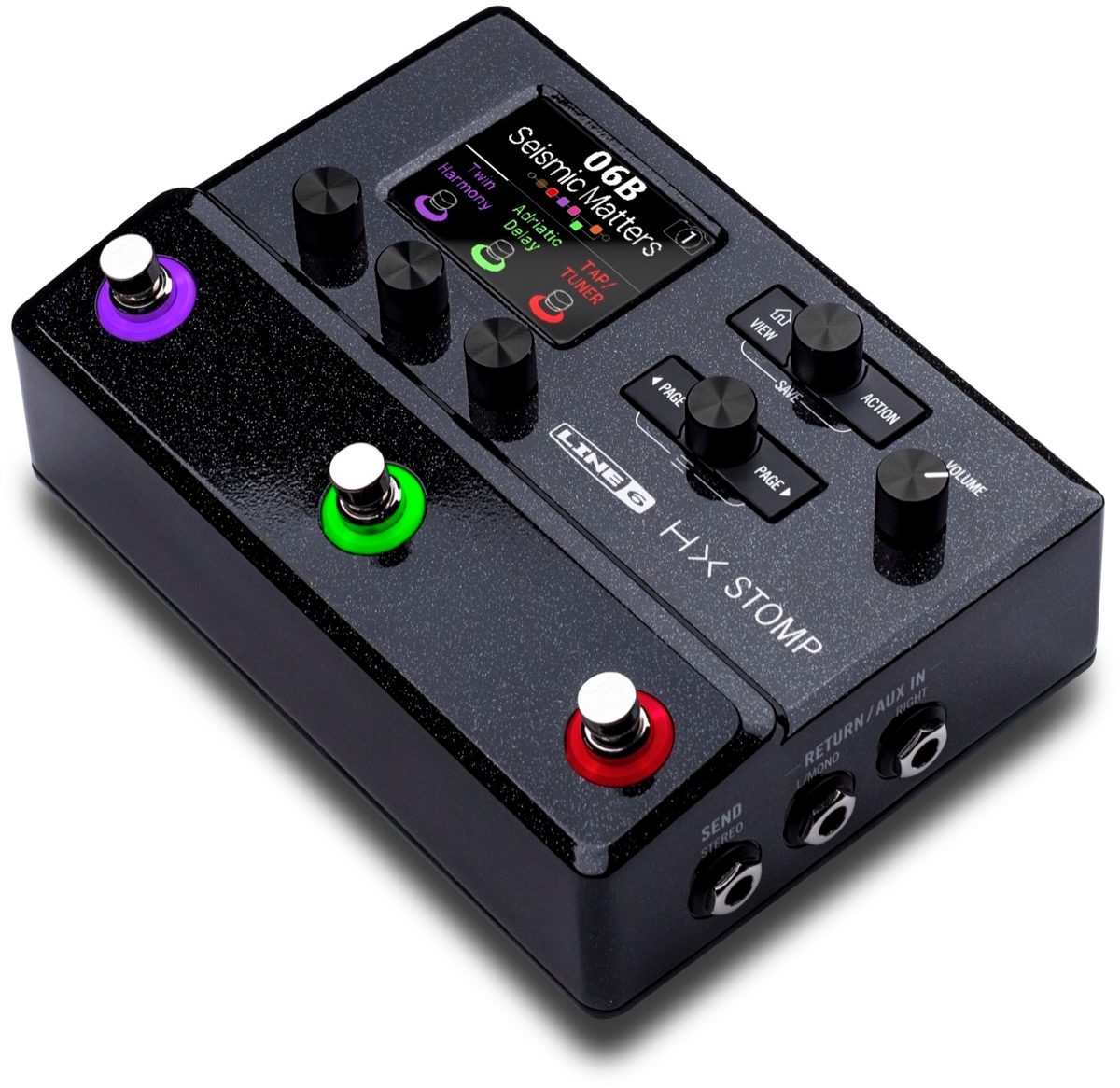
| HX Stomp è un processore per chitarra professionale che offre il suono di amplificatori, cabinet ed effetti Helix in un pedale ultra compatto. Sia che preferiate suonare attraverso una configurazione tradizionale di ampli e pedali, o andare direttamente sul palco o in studio, HX Stomp si integra perfettamente in una varietà di ambienti e applicazioni. Utilizzando la stessa tecnologia DSP e HX Modeling dei suoi fratelli Helix maggiori, il pedale per chitarra HX Stomp si adatta facilmente alla tua pedaliera, o persino nella tasca della tua borsa da concerto. Ci sono oltre 300 amp, cab ed effetti - incluso un looper. HX Stomp contiene tutti i modelli HX presenti nei prodotti della famiglia Helix, oltre alla libreria di effetti legacy dei pedali Line 6 M-Series e ai modellatori di stompbox come il DL4. Usalo come un "super stompbox", uno strumento di backup o da viaggio, un expander di suoni aggiuntivi se combinato con altri modellatori, un'interfaccia audio - o persino uno strumento completo per chitarra e basso. |
Caratteristiche
- La potenza di elaborazione della famiglia Helix in un compatto stomp a 3-pulsanti
- Telaio in alluminio estremamente compatto
- Oltre 300 modelli di amp, cabinet e stomp della famiglia Helix, serie M e legacy di Line 6
- 126 Preset per coprire le applicazioni di gigging reali
- Fino a 6 blocchi per preset
- Motore audio 24-bit/96kHz di qualità eccellente e con modellazione realistica
- Brillante display a colori da 2.4"
- Loop FX per effetti a pedale
- Integrazione in setup a 4-cavi
- Performance stereo dall'input all'output
- Funzionalità MIDI per switch tradizionali e integrazione in setup avanzati
- Funziona anche come interfaccia audio USB con funzionalità di re-amp
- True bypass
- Pratica gestione delle patch e degli aggiornamenti firmware
- Dimensioni: 178 x 126 x 66mm
- Peso: 800g
Headrush Gigboard

Boss GT-1000

Con una qualità del suono e un’espressività musicale imbattibili, il GT-1000 inaugura una nuova era nelle prestazioni dei processori di effetti/simulazione di amplificatori. In questo dispositivo dal suono superiore, debutta la nuova rivoluzionaria tecnologia AIRD (Augmented Impulse Response Dynamics), figlia della pluriennale ricerca avanzata BOSS, e supportata da un motore DSP ad altissima velocità, da convertitori AD/DA a 32-bit, elaborazione in virgola mobile a 32-bit, e frequenza di campionamento a 96 kHz lungo tutto il percorso audio.
Basato sul famoso approccio Tube Logic di BOSS, il sistema completo AIRD presente nel GT-1000 garantisce una risposta musicale ed una flessibilità unici in un processore effetti per chitarra. Gli amplificatori AIRD “vivono e respirano” come veri amplificatori valvolari, con un feel pieno di ispirazione, e dinamiche timbriche dal realismo sino ad oggi irraggiungibile. E con la sofisticata funzionalità AIRD Output Select, potete ottenere questo sound entusiasmante in ogni occasione, con qualsiasi setup, dagli amplificatori per chitarra standard, alla registrazione diretta, sino alle applicazioni di monitoraggio full-range sul palco.
Il GT-1000 è anche dotato di una vastissima selezione di innovativi effetti BOSS che migliorano il vostro suono, con numerose opzioni di collegamento e un esteso controllo in tempo reale a vostra disposizione. E con la praticità del Bluetooth® incorporato, potete regolare i suoni, configurare le assegnazioni di controllo e organizzare le patch in modalità wireless dal vostro dispositivo mobile usando la app BOSS Tone Studio. Con un’immensa potenza creativa in un design professionale elegante e leggero, GT-1000 è un modello innovativo e rivoluzionario che offre nuovi livelli di espressività musicale ai chitarristi di tutto il mondo.
Atomic AMPLIFIRE 3
.jpg)
We designed Amplifire as an instrument that we, as guitar players, wanted for ourselves. This meant it had to sound/feel authentic and amazing while being easy-to-use, transport and be road rugged all without breaking the bank.
Amplifire is equally capable of being a complete rig replacement or part of a larger pedal board and/or outboard processing rig.
Boss GT-001
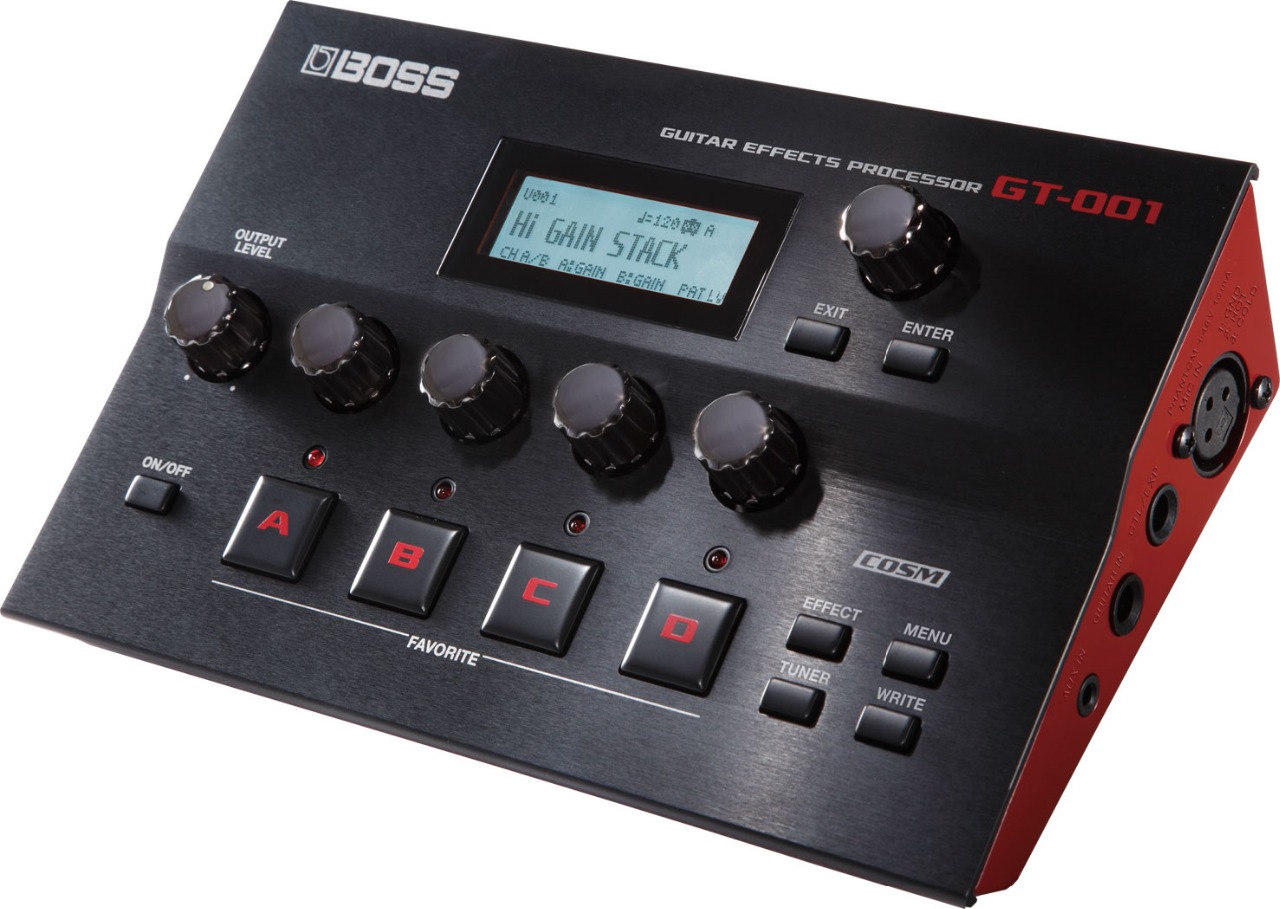
Caratteristiche tecniche:
Effetti e amp di massima qualità in un’elegante unità desktop
Include gli ultimi modelli BOSS di COSM amp, potenti effetti MDP, e altro
Doppia effects chain per routing degli effetti flessibile
Avanzata interfaccia USB audio/MIDI multi canale per una registrazione ed un reamping flessibile
Compatibile con le patch della GT-100 Version 2.0
Manopole su pannello per la regolazione dei suoni e tasti dedicati per il richiamo dei suoni favoriti
BOSS TONE STUDIO editor/librarian per Mac/Windows e patches custom disponibili sul sito bosstonecentral.com
Ingresso microfonico XLR con phantom power, ideale per voci o strumenti acustici.
Ingresso da 1/8” per collegare un dispositivo audio esterno tipo smart phone o lettore musicale
Conversione monofonica guitar-to-MIDI da un normale ingresso guitar da ¼”
Ingresso per collegare un pedale d’espressione o fino a due footswitches per controllo e cambio effetti/patches
Alimentazione via USB bus o alimentatore AC incluso
Zoom G3
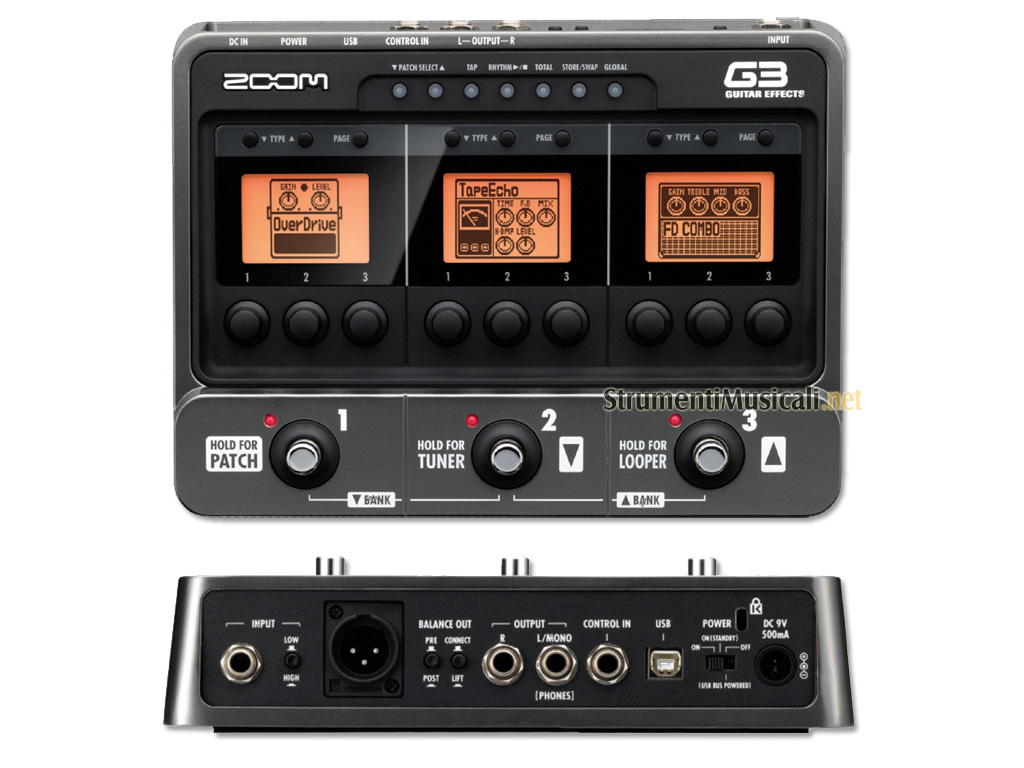
Caratteristiche principali:
· 100 preset programmabili
· Oltre 100 effetti selezionabili per ognuno dei 3 moduli
· Simulazioni di ampli e diffusori per chitarra
· Simulazioni microfoni da studio
· Fino a 3 effetti/simulazioni applicabili contemporaneamente
· Porta USB 2.0
· 2 Output Uscita recording XLR
· Uscita cuffie
· Ingresso Control In per pedale espressione (opzionale)
· Interfaccia audio
· Drum machine con 40 pattern ritmici inclusi , funzione TAP looper con 40 sec. di memoria
· In bundle i software Edit&Share e Steinberg Sequel LE
· Alimentazione via USB o con 4 batterie AA/LR6 o con alimentatore AC
Lo Zoom G3 è un dispositivo completo ed avanzato per i chitarristi con tutto il necessario per il vostro strumento. Questo prodotto di Zoom è un multieffetto, uno speaker emulator e un'interfaccia audio per la registrazione, ma ad un prezzo eccellente, come sempre con i prodotti di Zoom, e con alcuni software inclusi interessanti. In più, lo Zoom G3 è il più veloce nel cambio delle patch al mondo, soltanto 1ms!
Vediamo tutte le caratteristiche dello Zoom G3.
3 in 1
Come potete vedere nell'immagine, lo Zoom G3 è stato progettato per essere usato facilmente e rapidamente. Il dispositivo è diviso in tre parti, ciascuna con display, selettore e tre manopole.
L'utente può utilizzare simultaneamente fino a tre effetti ed i settaggi di ogni effetto sono facili e veloci.
13 amplificatori, 94 pedali e 100 effetti
Con il G3 Zoom introduce una nuova tecnologia per la simulazione degli amplificatori e per gli effetti, grazie al nuovo DSP, lo ZFX-IV. Ogni amplificatore (Fender Twin Reverb '65, Fender Bassman, Mesa/Boogie Dual Rectifier ed altri) può essere accoppiato ad un Cabinet differente. L'uscita può essere commutata per il live o per la registrazione.
In più, lo Zoom G3 può emulare 94 pedali differenti (Ibanez TS808 Tube Screamer, Boss OD-1, Boss MT-2 Metal Zone, Boss DS-1 e molti altri) e fornisce 100 effetti. L'utente può memorizzare gli effetti in 100 patch (10 patch x 10 banchi).
Il looper e la drum machine
Lo Zoom G3 è fornito di looper, che può registrare fino a 40 secondi di audio, e di una drum machine con 40 pattern ritmici.
Il software incluso e Edit&Share
Lo Zoom G3 fornisce un software per la registrazione: Steinberg Sequel LE. Con l'USB e Sequel LE, il G3 può essere usato come interfaccia audio per la registrazione, o come un piccolo home studio portatile.
In più l'utente può scaricare dal sito web di Zoom un altro software: Edit&Share. Questo software può essere usato per modificare e memorizzare le patch sul computer.
Digitech RP155
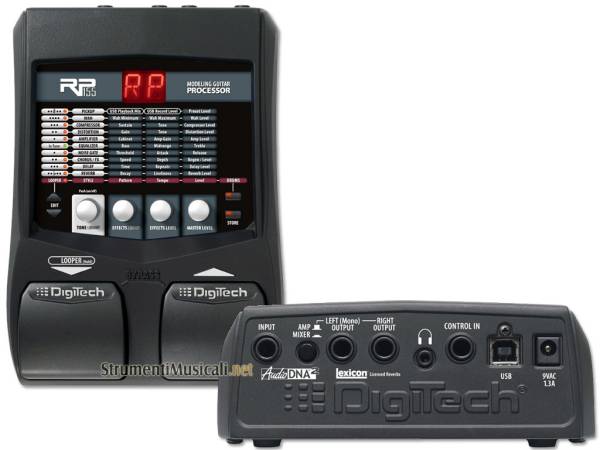
RP155 è un processore multi-effetto per chitarra con 83 amplificatori, cabinet, pedali ed effetti che consentono di ottenere praticamente qualsiasi suono si desideri, proprio come i professionisti.
Con USB streaming audio, RP155 permette di registrare facilmente DAW direttamente sul computer con suoni tali che penseranno che il vostro brano sia stato registrato in uno studio importante.
Caratteristiche:
20 Second looper
83 Amps, cabinets, pedali ed effetti
23 Amp/Tipi Acoustic
12 tipi di Cabinet
Riverberi Lexicon
30 toni e 30 effetti Biblioteche
100 preset (50 di fabbrica, 50 utenti)
Cubase software di masterizzazione incluso LE4
Fino a 5 secondi di delay
Velocità di campionamento a 24 bit 44.1kHz
60 pattern di batteria di alta qualità
2 x 2 USB audio streaming
Modifica USB tramite DigiTech X-Edit
Uscite indipendenti 1/4" Left e Right
Amp/Mixer switch to engage speaker cabinet model
Stereo 1/8" Uscita cuffie
Built-in sintonizzatore cromatico
Telaio pressofuso resistente
Alimentatore incluso
LINE 6 Pod XT
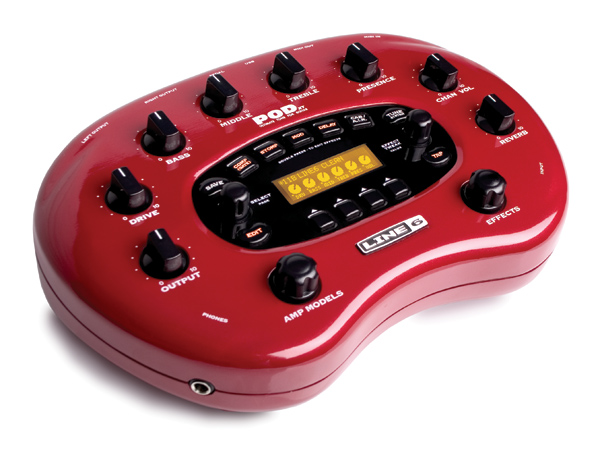
Caratteristiche
32 modelli di amplificatore22 modelli di diffusore
4 modelli di microfono
64 preset programmabili
oltre 45 modelli di effetto
accordatore automatico incorporato
uscite stereo bilanciate
ingresso/uscita MIDI
uscita USB
uscita cuffie
ROCKMAN Sustainor

Introduction
The Sustainor is the heart of every Rockman rig. It is certainly the most complex and the most charismatic of the Rockmodules: its development required several years from a complete team of engineers, probably working separately on sections of the Sustainor.
Though its sound signature is immediately recognizable, the possibilities and versatility of the Rockman Sustainor are almost endless, still over twenty years later.
Certainly the first high-end analog amp simulator ever built, the Sustainor is, still today, an outstanding device, far above the classical preamp image that some people have of it.
Objective and history
The basis of the Rockman Sustainor is the amp simulation of the Rockman headphones amps. If one considers that the Rockman and the X100 are semi-professional devices, then the Sustainor stands as the professional extrapolation: while the headphone amps are based on four preset sounds, the Sustainor was extended by several complex, smart and useful inventions.
The Rockman headphone amp was created by Tom Scholz and issued in 1982. SR&D improved it continuously between 1982 and 1986, without significant changes: only minor circuit tweakings.
In the meantime, Tom Scholz had imagined the improvements that would give birth to the Sustainor:
Adjustable gain stages, volume controls and filters.
A noise reduction circuit: the Smart Gate
A truly amazing feature: the Autoclean
A 4x12' cab simulation: the Phase Notcher
When did the studies for the Sustainor begin? Probably right after the issue of the Rockman: 4 years is not much when the deal is to stuff 1kg of components in the volume of a pocket book! All in all, the Rockman Sustainor was issued as a commercial product in January 1986, along with the Rockman Chorus/Delay.
The Sustainor, like all the Rockman products, was continously improved. The first commercial items correspond to the REV03, knowing the last commercial release, in 1989, was REV09.
The first models had this blue logo that make us call them "Blue face", and the rear plate was stamped "100" (as a matter of fact, all the Rockmodules are stamped 100 and it's more an enclosure type than anything else). SR&D sold almost 9000 Sustainors in 1986. In February or March 1987 (circa S/N 10000), the rear plate was stamped 100A, and the blue logo was still here. These 100A Sustainors have nothing special: they are just the last Blue-Face Sustainors, a sort of transition model before the change of logo.
In October 1987, the logo on the frontplates of the Rockmodules (i.e. the Sustainor, the Chorus/Delay and the Instrument EQ) received a white logo instead of the original blue one. The Chorus/Delay was actually discontinued, and the existence of white-faced C/D's or blue-faceed EQ's as commercial products is not proved.
The change of logo was accompanied, for the Sustainor, by a change of rear plate: it was now stamped 200 instead of 100. The front plate was slightly modified, and all these changes make us speak about the Sustainor 200, though the 200 is just a continuous improvement of the 100, not a different product.
Inside the Module
The Sustainor is complex. Very complex. While the amp simulation circuit of the original Rockman took only 6 OpAmps controled by only one mechanical switch, the Sustainor is made of 28 Opamps with a complete network of mechanical and J-FET switches.
ROCKMAN Instrument Equalizer

Introduction
In a first approach, an equalizer is only an equalizer. Something simple that all the manufacturers should be able to design correctly.
But if you ask someone like Tom Scholz if the common commercial devices fit his requirements, the answer is less obvious.
The Rockman Instrument EQ is just different and better than what's available on the market. Let's see what makes its qualities and differences.
Inside the Module
The first thing that a tech will see inside the Instrument EQ is... no 4053/4066 chips! These J-FET IC's are everywhere in the other modules, and were not used in the EQ. As a matter of fact, SR&D designed it for the best signal-to-noise ratio, and selected a +/-12V power supply - instead of +/-8V - that prevented from using the integrated switches (the bypass circuit is therefore based on discrete J-FET's).
ROCKMAN Stereo Chorus

Introduction
The Rockman Stereo Chorus was introduced in 1987, when the older Chorus/Delay was discontinued. Based on the same circuit, it has the same qualities, plus some improvements that make it a genuine reference.
Objective and history
The Chorus/Delay was a combined unit. Like in all the multi-effects, some features were limited: some footswiches would have been welcome, but the rear panel was simply too small for that...
The new Stereo Chorus was therefore entirely dedicated to the chorus function, and all the switches were now remote-controled. The Stereo Chorus has a total of four footswitches:
Bypass
Long-Chorus
Sweep Stop
Alt-Mix
The possibilities are of course huge, and the technical quality of the unit - already great for the Chorus/Delay - were improved again.
Inside the Module
The Stereo Chorus has the same structure and circuits as the Chorus/Delay. This includes of course the noise reduction compandor.
The key difference is the BBD's: the Chorus/Delay has one MN3005 chip (up to 200ms), while the Stereo Chorus is based on two MN3007 (up to 50ms each). The choice of two BBD's was made to allow a silent switching between the Normal (20ms) and Long-Chorus (40ms) chorus modes.
ROCKMAN Stereo Echo

Introduction
The Rockman Stereo Echo is often considered as the Holy Grail of the analog delays.
Well, it's only fair!
There aren't many quality analog delays on the market, especially since this technology was replaced by the cheaper digital technology.
The Rockman Stereo Echo not only uses state-of-the-art analog circuits, its functional design was, like every other Rockman unit, performed by a musician for musicians.
And that makes a huge difference.
Objective and history
The Stereo Echo was issued along with the Stereo Chorus when the Chorus/Delay was discontinued in 1987.
And the delay section of the older C/D looks really simple compared to the highly improved Stereo Echo!
While the Chorus/Delay was limited to doubling, slap-back and reverb-like short echoes, the Stereo Echo can deliver these huge walls of sounds that a tape echo can give.
As a matter of fact, the filters of the Stereo Echo were designed for this warm, tape-like sound - nothing like the cold feeling of a digital unit.
The stereo effect of the SE is unique: the left channel delay is always equal to 3/5 of the right channel delay. This ratio was introduced to avoid taps overlapping: the echoes interleave from left to right and right to left without crossing path.
This special feature allows the Stereo Echo sounding a little like a reverb - something that no classic delay can do.
nside the Module
Just like the Stereo Chorus and the Chorus/Delay, the Rockman Stereo Echo includes the compandor noise reduction circuit. This is one of the key features that make it sound clean, when the common analog delays are fairly noisy at long delay settings.
There are four BBD chips inside the Stereo Echo, which are connected in series. The Left Channel - short delay - is picked up after the third chip, and the last chip provides an extra delay for the Right Channel.
ROLAND GP8


Roland Gp-8 Guitar effects processor (1987)
The Roland GP-8 Guitar Effects Processor dates back to the eighties and was basically hyped as eight BOSS compact pedals thrown into one rack unit (BOSS is a division of Roland). Quick and easy to manipulate sounds once you get a feel for the wheel. MIDI capability, effects loop, and foot pedal input give plenty of additional options.
The eight effects include: Compressor, Dynamic Filter, Overdrive, Distortion, Phaser, Equalizer, Digital Delay (12-bit) and Digital Chorus(12-bit).
BOSS Compression/Sustainer CS-3
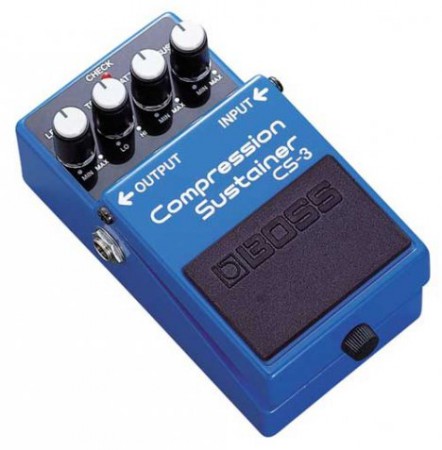
Boss CS-3 Compression Sustainer
With the Boss CS-3 Compression Sustainer you get smooth sustain, a more balanced string response, and more clarity and punch at any volume. A must for recording. Ideal alone for a clean sound or in front of a distortion or chorus.
Boss CS-3 Compression Sustainer features:
Compact compression/sustainer pedal with high-quality circuitry
Compresses loud signals and boosts softer signals for a smooth overall sound
Onboard Level, Tone, Attack and Sustain controls for precise tonal shaping
Low-noise design for super-quiet operation
BOSS SUPER CHORUS CH-1
.jpg)
Boss CH-1 SUPER Chorus Pedal
The versatile Boss CH-1 SUPER Chorus produces the swirling chorus sounds heard on many rock, jazz, country, funk, and other popular music recordings.
Boss CH-1 SUPER Chorus Pedal features:
Classic BOSS chorus pedal with clean, brilliant sound for guitar and keyboards
Effect Level, EQ, Rate and Depth knobs allow for precise shaping of sound
Features Mono input and Stereo outputs for connection to dual amps
BOSS 5-year warranty
BOSS Digital Delay DD-3
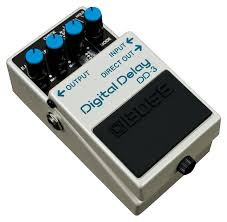
Boss DD-3 Digital Delay
With three delay-time modes, the Boss DD-3 Digital Delay Pedal can handle all your performance needs. Features delay times that range from 12-1/2 to 800ms. Produces endless repeats on demand in Hold mode. Comes with a 5-year warranty.
GUYATONE PS-017 Distortion Chorus
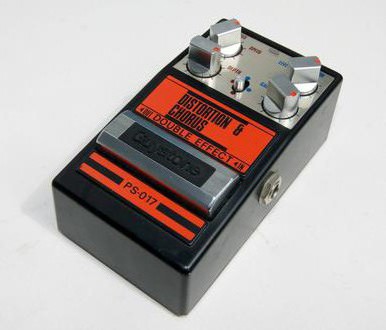
Guyatone Flanger PS-004
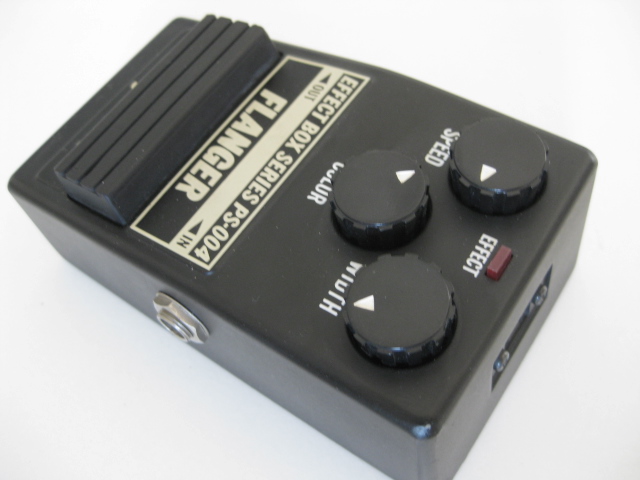
As well as the usual flanger sounds, this pedal will also oscillate (like a delay pedal) when the Color control is turned right up
Loco Box CH-01 Stereo Chorus

IBANEZ UE 305

Ibanez UE305, Multi-Effects Pedal,
Compressor/Limiter, Analog Delay, Stereo Chorus
Made in Japan
ROSS Phaser

This Phaser is amazing. The effect is very sweet sounding. There are only 2 knowbs on this effect and I don't think at any position there is a real bad sound. You know how there are setting on almost every pedal that you can say, well there's no use for that sound, well this phaser doesn't have that.
There is a nice range on both knobs, and there is no harse tone. The analog effect sound is real warm.
Good Points: Great range on settings, very warm sound. Indestructible.